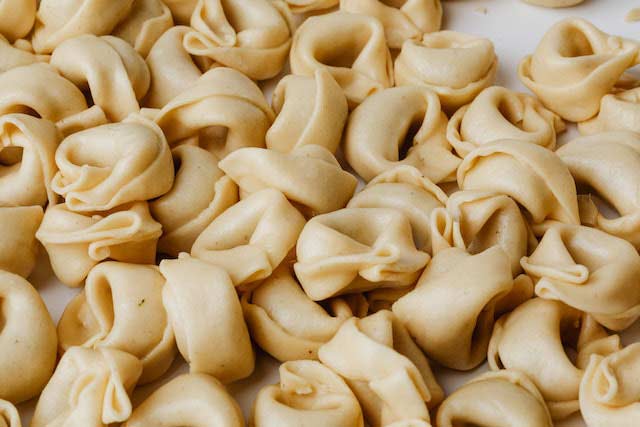Fresh Pasta

Pasta is a staple food in Italian cuisine, and it has a long history that dates back centuries. The exact origin of pasta is unknown, but it is believed to have been first made in ancient China around 4,000 years ago. From there, pasta spread to the Middle East and then to Europe, where it became a popular food in Italy.
In Italy, pasta has been a part of the culinary culture for hundreds of years, and there are hundreds of different shapes and types of pasta. Each region of Italy has its own specialty pasta dishes, and many families have their own secret recipes for making pasta dough.

Traditionally, pasta dough is made using only a few simple ingredients: flour, water, and sometimes eggs. The quality of the flour is key to making good pasta, and many Italian families use a specific type of flour for their pasta, such as semolina or tipo 00 flour.
Pasta dough is typically mixed by hand, and then rolled out using a rolling pin or pasta machine. The dough is cut into various shapes, such as spaghetti, linguine, or ravioli, and then cooked in boiling water until it is al dente.

Today, pasta is enjoyed all over the world and has become a staple food in many cultures. It is served with a wide variety of sauces and toppings, and it can be made with different types of flour to accommodate various dietary restrictions. Whether you prefer traditional Italian pasta dishes or modern twists on classic recipes, pasta is a versatile and delicious food that has stood the test of time.
Fresh Pasta
Difficulty: Easy4
servings45
minutes2
minutes200-250
kcal49
minutesCalories: A serving of pasta made from this recipe (without any sauce) is about 200-250 calories, depending on the size and shape of the pasta.
Ingredients
2 cups of all-purpose flour
2 large eggs
1/2 teaspoon of salt
1-2 tablespoons of water (if needed)
Directions
- In a mixing bowl, combine the flour and salt.
- Make a well in the center of the flour mixture and add the eggs.
- Use a fork to beat the eggs and slowly incorporate the flour into the eggs.
- Once the dough starts to come together, use your hands to knead the dough until it becomes smooth and elastic. If the dough is too dry, add 1-2 tablespoons of water.
- Cover the dough with a damp towel and let it rest for 30 minutes.
- After the dough has rested, divide it into four equal pieces.
- Roll out each piece of dough using a pasta machine or rolling pin. For thinner pasta like linguine and spaghetti, roll the dough out to the second-to-last setting on the pasta machine. For thicker pasta like tortellini, use the third-to-last setting.
- Cut the pasta dough into the desired shape.
- Boil the pasta in a pot of salted water for 2-4 minutes or until al dente.
- Drain the pasta and serve with your favorite sauce.
Colors
Spinach: To make green pasta, puree fresh spinach leaves in a blender or food processor until smooth. Add the spinach puree to the egg mixture and proceed with the recipe as usual.
Beetroot: To make pink or red pasta, puree cooked beets in a blender or food processor until smooth. Add the beet puree to the egg mixture and proceed with the recipe as usual.
Squid Ink: To make black pasta, you can add squid ink to the dough. Squid ink is available at specialty food stores or online. Add 1-2 tablespoons of squid ink to the egg mixture and proceed with the recipe as usual.
Notes
- Use good quality ingredients. The quality of the flour and eggs will affect the flavor and texture of the pasta. Use fresh, large eggs and high-quality, unbleached all-purpose flour.
- Don't skip the resting time. Letting the dough rest for 30 minutes allows the gluten to relax, making it easier to roll out the pasta.
- Don't overwork the dough. Knead the dough just until it becomes smooth and elastic. Overworking the dough can result in tough pasta.
- Dust the dough with flour. When rolling out the pasta dough, dust it with flour to prevent it from sticking to the pasta machine or rolling pin.
- Cook the pasta in salted water. Adding salt to the water enhances the flavor of the pasta. Use about 1 tablespoon of salt for every 4-6 quarts of water.
- Experiment with different shapes. Once you've mastered the basic pasta dough recipe, try making different shapes like ravioli, fettuccine, or lasagna.








